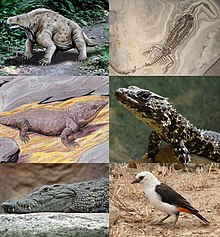| Sauropsids Temporal range:
| |
|---|---|

| |
| Clockwise from top left: Pareiasaurus (an extinct pareiasaurian parareptile), Mesosaurus (an extinct mesosaurian parareptile), Smaug breyeri (a lizard), Dinemellia dinemelli (the white-faced buffalo-weaver), Crocodylus niloticus (the Nile crocodile), and Labidosaurikos (an extinct captorhinid eureptile) | |
| Scientific classification | |
| Domain: | Eukaryota |
| Kingdom: | Animalia |
| Phylum: | Chordata |
| Superclass: | Tetrapoda |
| Clade: | Reptiliomorpha |
| Clade: | Amniota |
| Clade: | Sauropsida Watson, 1956 |
| Subclades | |
| |
Sauropsida (Greek for "lizard faces") is a clade of amniotes, broadly equivalent to the class Reptilia, though typically used in a broader sense to also include extinct stem-group relatives of modern reptiles and birds (which, as theropod dinosaurs, are nested within reptiles as more closely related to crocodilians than to lizards or turtles).[2] The most popular definition states that Sauropsida is the sibling taxon to Synapsida, the other clade of amniotes which includes mammals as its only modern representatives. Although early synapsids have historically been referred to as "mammal-like reptiles", all synapsids are more closely related to mammals than to any modern reptile. Sauropsids, on the other hand, include all amniotes more closely related to modern reptiles than to mammals. This includes Aves (birds), which are recognized as a subgroup of archosaurian reptiles despite originally being named as a separate class in Linnaean taxonomy.
The base of Sauropsida forks into two main groups of "reptiles": Eureptilia ("true reptiles") and Parareptilia ("next to reptiles"). Eureptilia encompasses all living reptiles (including birds), as well as various extinct groups. Parareptilia is typically considered to be an entirely extinct group, though a few hypotheses for the origin of turtles have suggested that they belong to the parareptiles. The clades Recumbirostra and Varanopidae, traditionally thought to be lepospondyls and synapsids respectively, may also be basal sauropsids. The term "Sauropsida" originated in 1864 with Thomas Henry Huxley,[3] who grouped birds with reptiles based on fossil evidence.
- ^ Marjanović, D. (2021). "The Making of Calibration Sausage Exemplified by Recalibrating the Transcriptomic Timetree of Jawed Vertebrates". Frontiers in Genetics. 12. 521693. doi:10.3389/fgene.2021.521693. PMC 8149952. PMID 34054911.
- ^ Gauthier J.A. (1994): The diversification of the amniotes. In: D.R. Prothero and R.M. Schoch (ed.) Major Features of Vertebrate Evolution: 129–159. Knoxville, Tennessee: The Paleontological Society.
- ^ Cite error: The named reference
sauropsidawas invoked but never defined (see the help page).